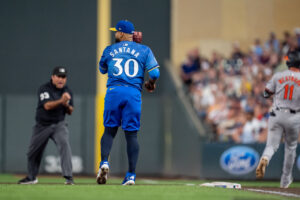Juan Soto arrived with the New York Yankees facing more pressure than anyone else on the team. This is a crucial year for both him and the Yankees franchise. The Bronx Bombers are looking to reach the World Series for the first time since 2009. As for Soto, he is entering a contract year where he could receive upwards of $500 million in free agency. However, he still has to perform to merit the price tag. In the early going, he has answered the call and has been the Yankees’ most important hitter, as he dismantled the Astros in Houston and is continuing to hit other opponents. To the jubilation of Yankee fans, Juan Soto has been much better than even they originally thought, and there are three key contributors to his early success at the plate.
Juan Soto slams his first homer in the Bronx as a Yankee! pic.twitter.com/tLTGyJaHZV
— MLB (@MLB) April 8, 2024
The Secrets of Juan Soto’s Early Success in Pinstripes
The Batting Stance
The first and obvious strength of Juan Soto’s early success is in his batting stance, which allows him to react to pitches late. Soto sits deep in the batter’s box, giving him hundredths of seconds more to react than if he would perhaps sitting more towards the middle. To the naked eye, it would be hard to see how this could make a substantial difference, but think of it like this. The distance to the mound is 60 feet, 6 inches meaning the ball needs to travel that distance to cross the plate as either a strike or ball. Most pitchers are good at hiding the ball to prevent hitters from seeing what pitch is coming. Therefore, the hitter is at a massive disadvantage when deciding whether to swing or not.
Since Soto, like many great hitters, sits extremely deep in the batter’s box, he can see the pitch for a longer time. This means the total distance for Soto is not 60 feet 6 inches, but potentially 63 feet 6 inches. That additional potential three feet more allows him to recognize if the pitch will likely be a ball or strike, which is why throughout his career, Soto has led the league in walks on three occasions.
An Eagle Eye
A by-product of Soto’s stance is how low he stays to the ground. It may not seem too crazy initially, but it serves two important functions. The first is that he can shrink the strike zone, allowing him to cover less space with the bat than he would standing tall. This increases the pressure on the pitcher, as they also have less room to maneuver and make mistakes. A great example of this is Jose Altuve and how his batting stance and height create a small strike zone for the opposing pitcher. This is why Altuve is one of the most difficult batters in Major League Baseball to retire and someone who led the league in hits four seasons in a row from 2014-2017.
The second benefit to Soto’s condensed stance is his ability to see pitches well. Since he already sits deep in the box and shrinks the strike zone, his eyes are closer to the incoming pitch than the average hitter. Soto can track the ball for a very long time before deciding whether to swing. The Yankees are seeing it pay dividends already as he works long counts and also gives his teammates good reads on what the pitcher has working in the game.
Juan Soto’s Level Swing
The most important part of Soto’s success is his ability to keep a level swing through the strike zone. If you look at Soto’s two most impressive hits so far, one would notice how he smoked the ball twice to left field. The first one was a home run in the Crawford boxes, the second was a game-winning hit against one of baseball’s best relievers in Josh Hader. It may not seem like much at first glance other than good pieces of hitting. However, there is a lot more to it than that. Soto could only hit those balls as well as he did if he had a level swing. If he had dropped the bat and gone for a more launch-angled approach, Soto would have popped out on both occasions. This is why Soto’s home run spray chart is not pull-heavy, but rather evenly spread to all fields.
Soto’s Approach Making Waves
Juan Soto has made the Yankees a significantly better team with his abilities at the plate. His approach has collectively motivated his teammates to work deep counts and hit line drives instead of home runs. This is particularly clear in the case of breakout star Oswaldo Cabrera, who changed his approach to hit line drives instead of going for power. He did this by watching Soto’s batting practices on how he tries to hit line drives to all parts of the park and not home runs.
Collectively, this is why the Yankee offense has been very prolific against strong teams early on. They are not only winning by hitting the long ball, but by hitting line drives all over the field. Juan Soto’s approach has a lot to do with the Yankees’ early success.
Photo Credit: © Gregory Fisher-USA TODAY Sports






